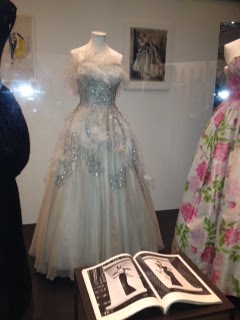The 1920s fashions show the "garconne" look, or the simple and straight style of the dress below. Fashions continued to be bright and vibrant and full of detail, often inspired my international fashion. For example, fans made of ostrich feathers like the one below were inspired by the excavation of King Tut's tomb in Egypt in 1922. Crazy!
The mid 1920s into the 1940s showed emergence of the style of the modern woman, especially through the Art Deco design and full length dresses that clung to figures. The below coat was designed by Elsa Schiaparelli in 1937. It has two possible images--a vase filled with roses, or two faces. This idea came from the influence of artists like Salvador Dali.
The Surrealist art movement also influenced dresses like the one below from 1937, also designed by Elsa Schiaparelli.
Finally, the '60s! The best time period. Below are two of the dresses from this era, showing off the haute couture of the industry. French designers particularly used feathers and other embellishments in their gowns to enhance their image.
Today I visited the Fashion Museum in Bath which also had some fascinating items and a lot more information. I'll continue posting about what I learned next week!

















